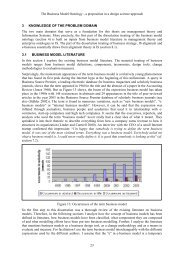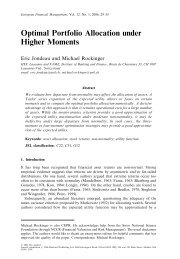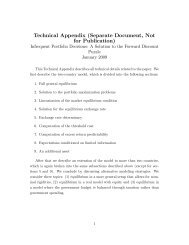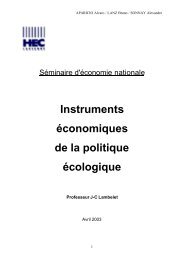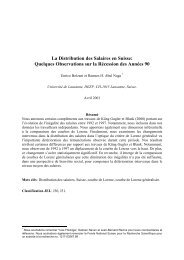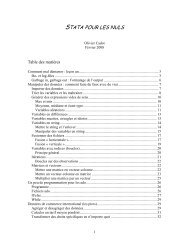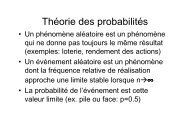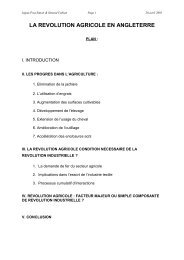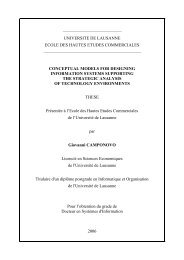Do consumer s tastes differ final 1.7. - HEC
Do consumer s tastes differ final 1.7. - HEC
Do consumer s tastes differ final 1.7. - HEC
You also want an ePaper? Increase the reach of your titles
YUMPU automatically turns print PDFs into web optimized ePapers that Google loves.
D O C ONSUMER’ S T ASTES D IFFER?<br />
control mechanisms. Individuals have less control over their culture than over general social capital as<br />
mentioned above. Culture strongly influences preferences and individual behaviour.<br />
Sustainable culture, in turn, depends very much on individual choices and personal capital. Thus a<br />
specific behaviour like cooperation can be sustained more easily without sanctions, if individuals are<br />
habitual and they were cooperative in the past, even if they could gain from uncooperative behaviour.<br />
When considering culture and tradition as part of social capital, there is a danger of creating<br />
interdependence between social and personal capital, which might lead to a less precise result.<br />
Other possible influence<br />
In neoclassical economic analysis, economic outcomes are determined by preferences, technologies<br />
and government policies. They include prices and wages, output growth rates, and the distribution of<br />
incomes. In Becker’s approach, the endogeneity of preferences implies that the economy also affects<br />
<strong>tastes</strong> regarding goods, leisure and other activities. Accordingly, economic outcomes are determined<br />
by preferences, but preferences equally influence economic outcomes.<br />
Addiction<br />
To introduce addiction into his model, Becker (1998) <strong>differ</strong>entiates between good addiction (good<br />
music) and bad addiction (drugs, e.g. heroin).<br />
On the one hand, positive addiction is examined. A person who has, for example, always listened to<br />
good music will therefore usually develop an even more refined appreciation of good music.<br />
Consequently, relative music appreciation rises with exposure. This is not due to a shift in favour of<br />
music, but to a sinking shadow price as skill and experience in the appreciation of music is acquired<br />
with exposure.<br />
On the other hand, Becker (1998) considers the effects of negative addiction. The long-term effect of<br />
heroin use on euphoric capital 16 might reduce its amount used at younger ages, or even discourage<br />
any use because of the anticipated harmfully addictive affects.<br />
An increase in consumption of a negative addictive good reduces the stock of consumption capital<br />
available subsequently. The shadow price will rise accordingly at all ages. Nevertheless, this does not<br />
indicate that the inputs of goods will fall with age and exposure; they are actually likely to rise with<br />
exposure if the commodity’s demand curve is inelastic.<br />
Thus, the use of drugs would grow with exposure at the same time that the amount of euphoria fell,<br />
if the demand curve for euphoria and thus for drugs were sufficiently inelastic. Consequently,<br />
addiction to drugs (a growth in use with exposure) is the result of an inelastic demand for heroin, and<br />
not the cause of an inelastic demand.<br />
Therefore, if there would be a case where it would not be evident whether addiction is harmful or<br />
beneficial, the elasticity of demand could be applied to distinguish between them. As depicted above,<br />
high elasticity indicates beneficial addiction, low elasticity the inverse. Additionally, we can derive<br />
effects of taxing and punishments like imprisonment. These measures will mainly transfer resources<br />
away from addicts if the goods are harmfully addictive, and for beneficial goods mainly reduce the<br />
addict’s consumption.<br />
One might question the above-mentioned aspects regarding the hypothesis of rational individuals<br />
maximising their utility by anticipating future consequences of their behaviour. Yet, the concept of<br />
addiction introduced here allows addicts to behave rationally as they maximise future utility with<br />
stable preferences. It is important to see that people not only get addicted to alcohol, heroin and<br />
16 “the commodity euphoria is produced with input of heroin, or alcohol or amphetamines”<br />
B EKE T INNEBERG 14<br />
19 MARCH 2003




